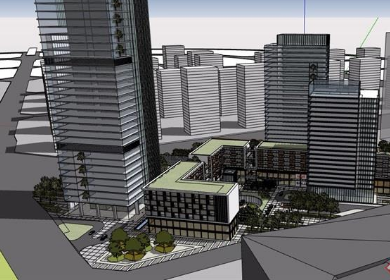点击此处,查看其余六篇建筑学硕士论文》》
建筑学硕士论文第六篇标题:孵化器建筑楼设计与构建分析
本篇文章目录导航:
【题目】孵化器建筑楼设计与构建分析
【第一章】众创时代企业孵化园建筑设计研究绪论
【第二章】区位优势、功能混合及环境心理学理论
【第三章】孵化器建筑的发展概述
【第四章】国内外孵化器建筑典型案例分析
【5.1-5.3】在孵企业人员和产业行为特征
【5.4-5.5】孵化器建筑的空间布局和设计原则
【5.6】孵化器建筑的空间设计策略
【5.7-5.8】孵化器建筑的设计风格
【第六章】孵化器建筑设计——以武汉光电创新园为例
【参考文献】创业园区建筑物设计与实现结语与参考文献
摘要
众创时代下国家政策和技术、资金等源源不断地支持,科技企业孵化器正大步迈入高速发展的“孵化器 4.0 时代”浪潮,孵化器在数量、场地面积、在孵企业、创造就业等方面的指标都呈现快速增长态势,中国已经成为世界孵化器大国。然而,日益增加的孵化空间需求与原有传统科技企业孵化器建筑简单依靠内部墙体分隔来进行空间划分的方式之间的矛盾就愈发明显。
如何为初创企业的在孵人员提供合适的建筑空间,如何设计建筑空间能更好地促进在孵人员的研发和创新,以及众创时代下新的孵化器建筑有什么相应的设计原则和设计策略,这些都是孵化器在建筑领域需要重点解决的问题。
带着对于这些问题的思考,结合国内外孵化器建筑、现代办公空间和环境心理学的相关理论研究,通过对孵化器建筑的发展与演变进行阐述,并针对孵化器的建筑特征和建筑特殊性进行归纳,将孵化器和一般办公建筑进行区分,并且对国内外孵化器建筑典型案例进行分析,从实际案例中归纳影响孵化器建筑设计的主要因素,从而总结其设计原则与策略。最后再以武汉光电创新园为例,探讨孵化器建筑设计原则和策略的实用性。

总结归纳适合孵化器建筑的设计手法,是满足高新技术从业者需求的表现、是引导孵化器建筑改革的必然要求、也是促进孵化器行业更好发展的内在需求。通过本文提出的分析与研究,希望能有利于提高在孵化器建筑中工作与生活的在孵人员的满意度,进而促进孵化器建筑设计的良性。
关键词:众创时代;孵化器建筑;影响因素;设计原则;设计策略;
ABSTRACT
In the age of mass creation, with national policies, technologies, and funds having been continuously supported, technology business incubators are striding into the rapid development of the "incubator 4.0 era". The incubator has a rapid growth trend in the number, the area, the incubating enterprise and the creation of employment, and China has become the Great power of world incubator. However, the contradiction between the growing demand for hatchery space and the way that the original traditional technology business incubator building relied solely on the separation of the internal walls to spatially separate it became even more apparent.
Therefore, how to provide suitable building space for incubators, how to design the building space to promote the development and innovation of incubators, and what are the corresponding design principles and design strategies for new incubator buildings in the era of innovation are the key problems that the incubators need to focus on in the field of architecture.
With the consideration of these problems and relevant theoretical research on incubator architecture and modern office space at home and abroad, the development and evolution of incubator architecture are elaborated, and the incubator's building characteristics and architectural specificity are summarized. In view of the architectural features and architectural particularity of the incubator, the incubator and general office building are distinguished, and the typical cases of incubators at home and abroad are analyzed, and the main factors affecting the design of incubators are summarized from the actual cases, and the design principles and strategies are summarized. Finally, Wuhan Photoelectric Innovation Park was taken as an example to discuss the practicality of incubator architectural design principles and strategies.
Summarizing the design techniques suitable for incubator building is a performance that satisfies the needs of high-tech practitioners, an indispensable requirement for guiding incubator building reform, and an important factor for promoting the development of incubator industry. The analysis and research proposed in this paper hopes to improve the satisfaction of work and life of incubators in incubator buildings and promote the design of incubator buildings.
Key Words: In The Age Of Mass Creation, Incubator Architecture, Influencing Factors, Design Principles ,Design strategies;
目录
目录
摘要
ABSTRACT
目录
图表目录
第一章 绪论
1.1 选题背景
1.1.1 时代及政策背景——众创时代的到来
1.1.2 孵化器的转型升级
1.1.3 论题的缘起
1.2 相关定义及阐述
1.2.1 孵化器的定义
1.2.2 孵化器的分类
1.3 研究对象及研究内容
1.3.1 研究对象
1.3.2 研究内容
1.4 国内外研究综述
1.4.1 关于孵化器的相关理论研究
1.4.2 关于现代办公空间的相关理论研究
1.4.3 国外的相关理论研究
1.5 研究的目的和意义
1.6 研究方法和拟采取的技术路线及研究可行性
1.6.1 研究方法
1.6.2 拟采取的技术路线
1.6.3 研究可行性
1.7 论文框架
第二章 基础理论研究综述
2.1 区位优势理论
2.2 功能混合理论
2.3 环境心理学理论
2.3.1 环境心理学的产生和发展
2.3.2 环境心理学与空间设计相关理论
2.4 本章小结
第三章 孵化器建筑的发展概述
3.1 国内孵化器的扶持政策
3.1.1 政策的主题分布
3.1.2 政策的区域影响对比
3.2 孵化器建筑的发展趋势
3.2.1 专业化发展
3.2.2 多样化发展
3.2.3 网络化发展
3.3 孵化器建筑的特征
3.3.1 工作环境开放化
3.3.2 信息化数字化
3.3.3 功能混合化
3.4 孵化器建筑的特殊性
3.5 本章小结
第四章 国内外孵化器建筑典型案例分析
4.1 北京中关村高端医疗器械产业园调研分析
4.1.1 项目概况——以“谷”为概念的大型孵化园区
4.1.2 功能布局——五大功能区,功能复合化开发
4.1.3 内部空间——大空间分隔模式
4.1.4 案例小结
4.2 中关村软件园孵化加速器
4.2.1 项目概况——以“自然”为概念的大型孵化器建筑
4.2.2 功能布局——垂直分区的功能分区
4.2.3 内部空间——完整孵化单元空间
4.2.4 案例小结
4.3 南京紫金(白下)高新技术产业园 D 地块
4.3.1 项目概况——“流动”的高层孵化办公楼
4.3.2 功能布局——水平分区的功能分区
4.3.3 内部空间——水平穿插休憩区的大空间模式
4.3.4 案例小结
4.4 广州万科云一期
4.4.1 项目概况——“漂浮的地平线”概念的地产孵化器
4.4.2 功能布局——以租赁办公和配套公寓为主的功能组成
4.4.3 内部空间——均质办公和公寓空间与跌落生态休息空间的融合
4.4.4 案例小结
4.5 荷兰乌得勒支科学园生命科学孵化器
4.5.1 项目概况——有层次的中型孵化楼
4.5.2 内部空间——采光大中庭设计的功能空间
4.5.3 案例小结
4.6 本章小结
第五章 影响孵化器建筑设计的主要因素及设计原则与策略
5.1 在孵企业的人员构成
5.1.1 年龄组成
5.1.2 受教育程度
5.2 在孵企业人员的行为和心理需求
5.2.1 在孵企业人员的行为需求
5.2.2 在孵企业人员的心理需求
5.3 在孵企业的产业行为特征与工作模式
5.3.1 在孵企业的产业领域
5.3.2 在孵企业的产业行为特征
5.3.3 在孵企业的工作模式
5.4 孵化器建筑的空间布局
5.4.1 功能构成
5.4.2 面积配比
5.5 设计原则
5.5.1 开放性原则(基于在孵企业开放工作模式的设计原则)
5.5.2 功能混合化原则(基于孵化器建筑的功能构成的设计原则)
5.5.3 可变性原则(基于在孵企业的产业行为特征的设计原则)
5.5.4 人性化原则(基于在孵人员的行为和心理需求的设计原则)
5.6 孵化器建筑的空间设计策略
5.6.1 界面消解,构建开放性
5.6.2 空间复合,营造混合性
5.6.3 模数应用,增加可变性
5.6.4 细节为重,体现人性化
5.7 孵化器建筑的设计风格
5.7.1 科技现代的建筑立面元素
5.7.2 丰富有趣的室内色彩设计
5.8 本章小结
第六章 孵化器建筑设计——以武汉光电创新园为例
6.1 武汉光电创新园的概况
6.2 武汉光电创新园的设计理念
6.3 武汉光电创新园的功能
6.3.1 功能组成
6.3.2 功能布局
6.4 孵化器建筑设计策略在武汉光电创新园上的应用
6.4.1 开放性设计策略的应用
6.4.2 混合化设计策略的应用
6.4.3 可变性设计策略的应用
6.4.4 人性化设计策略的应用
6.5 实例总结
6.5.1 优点
6.5.2 不足之处
6.6 未来孵化器建筑设计趋势展望
6.7 本章小结
结语
参考文献








